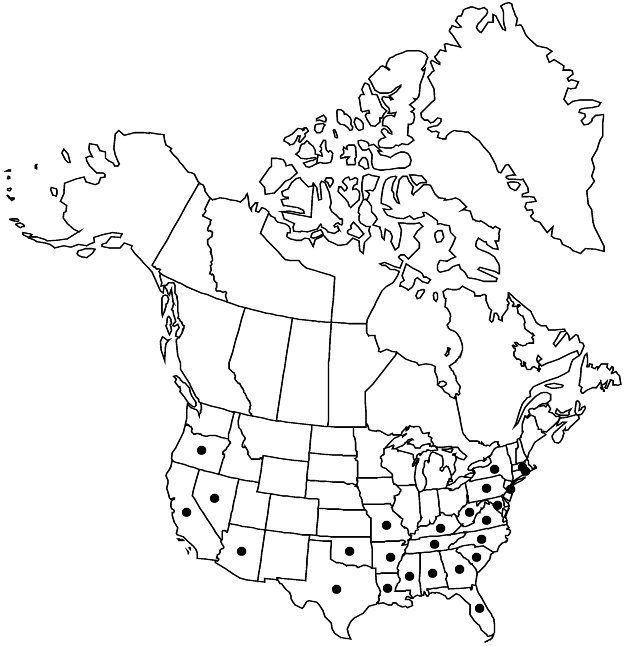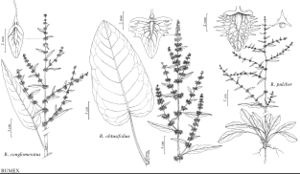Rumex pulcher
Sp. Pl. 1: 336. 1753.
Plants perennial, glabrous or distinctly papillose especially on veins of leaf-blades abaxially, with fusiform, vertical rootstock. Stems erect, often flexuous in distal part, branched in distal 2/3, occasionally almost from base, 20–60 (–70) cm. Leaves: ocrea deciduous or partially persistent at maturity; blade oblong to ovate-oblong, sometimes broadly lanceolate or panduriform, contracted near middle or proximally, 4–10 (–15) × (2–) 3–5 cm, less than 4 times as long as wide, base normally truncate or weakly cordate, occasionally rounded, margins entire, flat or undulate, rarely slightly crisped, apex obtuse or subacute. Inflorescences terminal, occupying distal 2/3 of stem or more, usually lax and interrupted, broadly paniculate, branches usually divaricately spreading, forming angle of 60–90° with 1st-order stem. Pedicels articulated in proximal 1/3 or occasionally near middle, thickened, not filiform, 2–5 (–6) mm, articulation distinctly swollen. Flowers 10–20 in rather dense whorls; inner tepals ovate-triangular, deltoid, or oblong-deltoid, 3–6 × 2–3 mm (excluding teeth), normally ca. 1.5 times as long as wide, base truncate, margins usually distinctly dentate, rarely subentire, apex obtuse to subacute, straight, teeth 2–5 (–9), normally on margins at each side, narrowly triangular, 0.3–2.5 mm, longer or shorter than width of inner tepals; tubercles (1–) 3, equal or unequal, usually verrucose (warty). Achenes dark reddish-brown to almost black, 2–2.8 × 1.3–2 mm. 2n = 20.
Phenology: Flowering late spring–summer.
Habitat: Waste places, roadsides, shores, fields, meadows, moist to dry habitats
Elevation: 0-1500 m
Distribution

Introduced; Ala., Ariz., Ark., Calif., Fla., Ga., Ky., La., Md., Mass., Miss., Mo., Nev., N.J., N.Y., N.C., Okla., Oreg., Pa., R.I., S.C., Tenn., Tex., Va., W.Va., s, w Europe, sw Asia, n Africa, elsewhere
Discussion
Rumex pulcher is an extremely polymorphic species consisting of five or six more or less distinct subspecies (K. H. Rechinger 1949, 1964). Three of these were reported by Rechinger (1937) from North America: subsp. pulcher; subsp. woodsii (De Not.) Arcangeli [= Rumex divaricatus Linnaeus]; and subsp. anodontus (Haussknecht) Rechinger f. Judging from herbarium specimens, subsp. woodsii seems to be the most common. However, J. E. Dawson (1979) noted that many North American specimens cannot easily be assigned to any subspecies.
Some records require confirmation, especially from the midwestern states, since Rumex pulcher often is confused with other species with dentate inner tepals. Records from Colorado (H. D. Harrington 1954) belong to R. stenophyllus (W. A. Weber and R. C. Wittmann 1992).
Selected References
None.
Lower Taxa
"/2" is not declared as a valid unit of measurement for this property.
